November 17. KOCHI "Backwater Tour" One of the biggest highlights of visiting Kerela was taking a backwater tour. The rivers and bays that were scattered down the Malabar coast from Kochi to Kollam were touted as one of the best things to do in India. The trips ranged from just day-long journeys to several 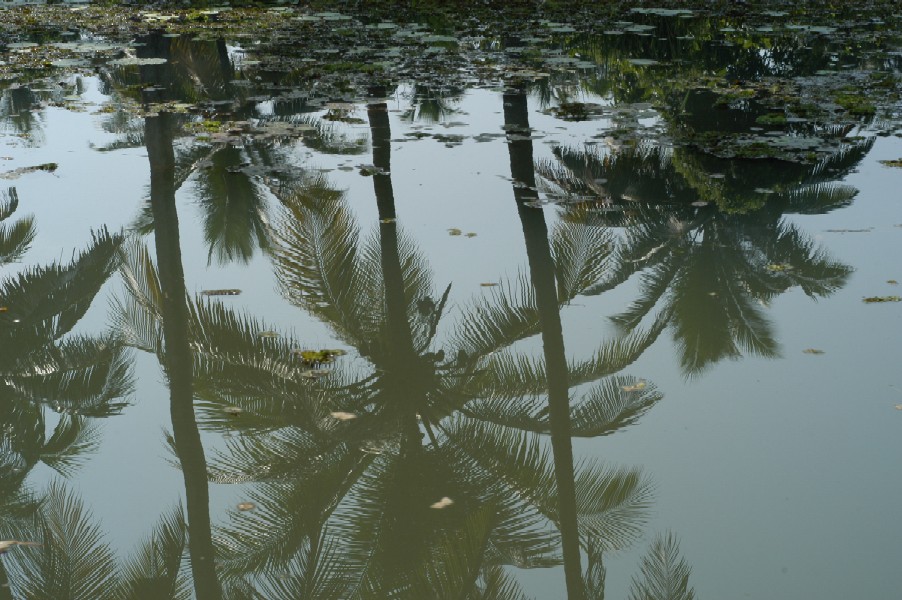 night excursions. The overnight trips could get quite pricey so we opted for a day cruise run by the Tourist Desk near the Ernakulum boat jetty. The trips were normally done on boats designed like traditional rice barges, long slender boats with woven siding arched over one end. A bus picked us up early in the morning and drove us for about 45 minutes to the boat. Our boat was adapted for tourist use and was covered from end to end. We took seats in the plastic chairs that night excursions. The overnight trips could get quite pricey so we opted for a day cruise run by the Tourist Desk near the Ernakulum boat jetty. The trips were normally done on boats designed like traditional rice barges, long slender boats with woven siding arched over one end. A bus picked us up early in the morning and drove us for about 45 minutes to the boat. Our boat was adapted for tourist use and was covered from end to end. We took seats in the plastic chairs that 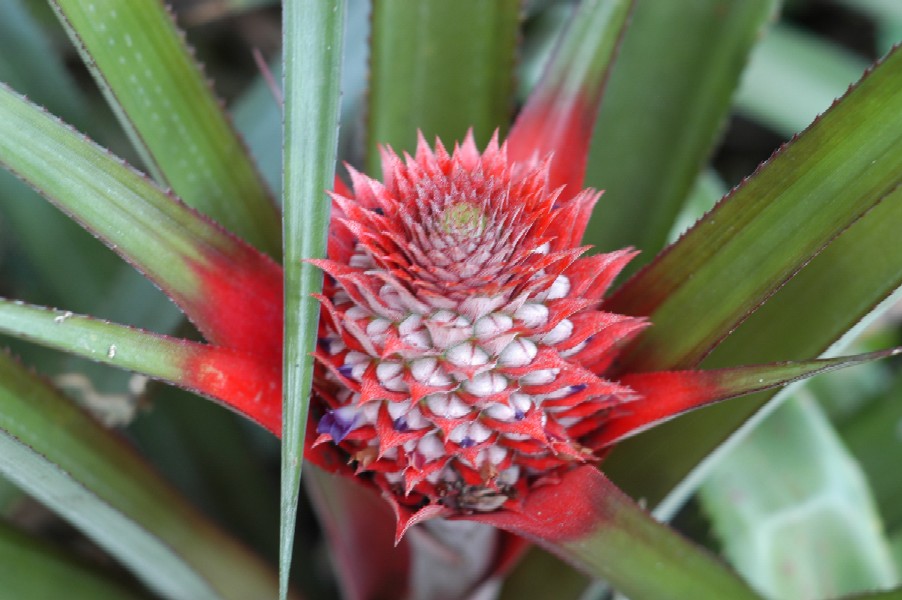 were arranged around the sides, turning them to face the scenery instead of the other tourists. Sitting next to us was a mother and daughter from California. We spent much of the time talking with them as the boat plied the waterways. were arranged around the sides, turning them to face the scenery instead of the other tourists. Sitting next to us was a mother and daughter from California. We spent much of the time talking with them as the boat plied the waterways.
The weather was clear and warm, and the water was calm. It was a very serene experience; a perfect way to spend the day. The backwaters were like a rural neighborhood where the people had waterways instead of roads. The boat passed along the channels and we could see people going about their day. Wash was hanging on lines, kids were playing. It felt a bit like we were walking through people's backyards; almost voyeuristic at times. We saw many smaller boats moving through the waters transporting people and goods. In general the people were very tolerant of our peeping. We waived and they waived back. The boat passed a cluster of smaller boats that were being loaded with sand by a group of men. The were standing in the shallow water and ducking under to scoop up the sand, bringing it up in a bucket and dumping it in one of the boats. They looked less certain of our presence. Who really wants tourist ogling while they are trying to get on with some hard work? But, we still got waives out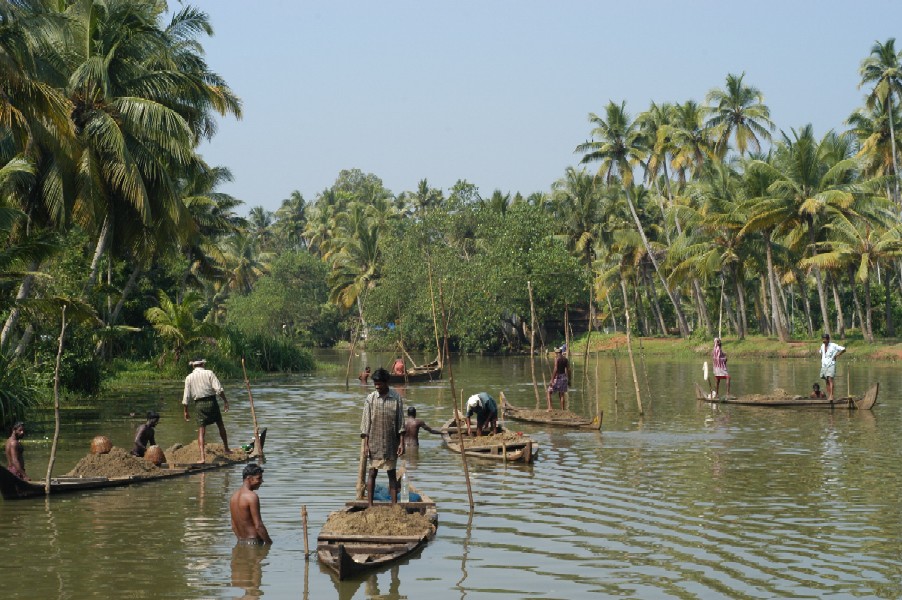 of a couple of them. of a couple of them.
After a while on the water we reached some narrower channels and eventually stopped along one of the islands. They gave us a little spice tour around one of the farms. It wasn't as extensive as the one we'd had in Zanzibar but there were many of the same spices, like black pepper and vanilla beans. It was a good refresher for us but the most interesting thing for me were the rubber trees. Several of them were being drained and had little cups tied around the trunks to catch the white sap. We had seen some rubber trees in Africa but not up close. After the spice tour we were back on our boat and slowly returned to where we started. They served us a tasty Kerelan lunch on the boat before shuttling us to another part of the backwaters for the last part of the day.
The final part of our tour was boat ride through even narrower canals. The group was split up into three groups and we packed into three long flat bottomed boat. Polers moved us slowly through the narrow waterways. The boats were covered but the canopy of green that overhung the canals provided sufficient protection from the sun. The boats pulled over and we got out in front of a small house where women were making coir (coconut fiber) rope 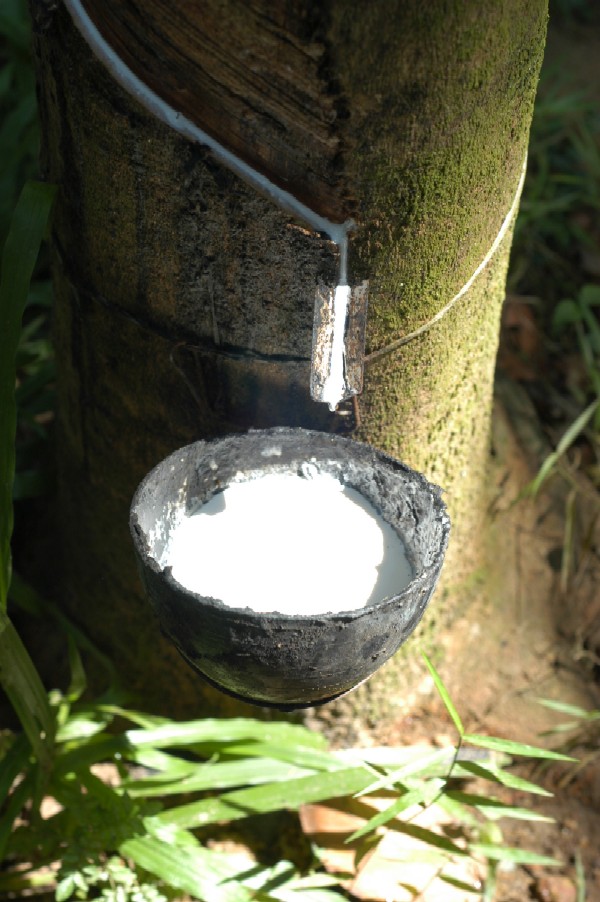 s. One woman sat in front of a spinning wheel that was the starting point for the rope making. The other two women had little satchels of coir around their waists and pulled out tufts that they attached to the wheel. The spinning wheel twisted the coir into two long strands of twine as the women slowly walked backwards, adding coir as they went. They made four strands of twine was long and then used the spinning wheel to twist them into a larger rope. It was a simple operation but rather a lot of work to make rope! The women were used to the tourist but were still shy. s. One woman sat in front of a spinning wheel that was the starting point for the rope making. The other two women had little satchels of coir around their waists and pulled out tufts that they attached to the wheel. The spinning wheel twisted the coir into two long strands of twine as the women slowly walked backwards, adding coir as they went. They made four strands of twine was long and then used the spinning wheel to twist them into a larger rope. It was a simple operation but rather a lot of work to make rope! The women were used to the tourist but were still shy.
Back in the boats we moved farther into the canals until we reached a small bridge. We unloaded again and crossed the bridge to where a tall group of coconut trees were standing. Rob and I already guessed what was next. A local man climbed a tall coconut tree by inserting his feet into a loop of coir rope. The rope kept his feet close to together as he inched up the trunk. We all stood back as he tossed down a bunch of coconuts. W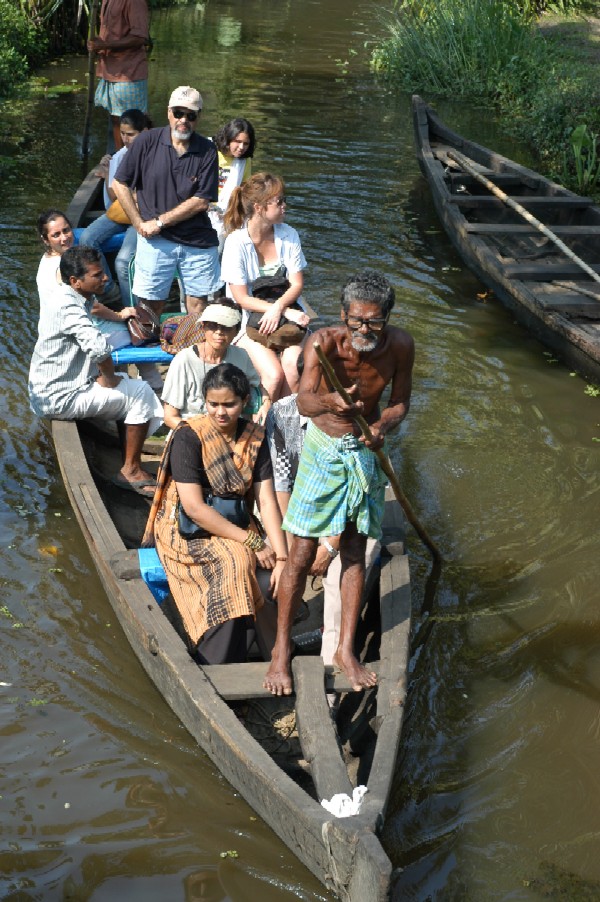 e'd had one man tell us that the locals didn't drink the coconuts very often because they were worth too much on the tourist market. That seemed a bit sad Drinking a young coconut was such a nice experience and should hardly be just the privilege of the tourists when the trees are growing in people's back yards. They used a small machete to hack open the coconuts without shucking the outside. It was hot out and we heartily drank the refreshing coconut juice. e'd had one man tell us that the locals didn't drink the coconuts very often because they were worth too much on the tourist market. That seemed a bit sad Drinking a young coconut was such a nice experience and should hardly be just the privilege of the tourists when the trees are growing in people's back yards. They used a small machete to hack open the coconuts without shucking the outside. It was hot out and we heartily drank the refreshing coconut juice.
Back in the boats we returned through the canals to our bus and had another 45 minute drive back to Ernakulum. The backwater tour was a wonderful experience. It was very touristy but still worth it. With a bigger budget the overnight trip would be great but we were already splurging on Lakshadweep so it would have to wait until next time.
November 18. KOCHI "Cooking in Kerela" During one of our afternoons in Fort Cochin we had stopped at the Delight Tourist Resort to look into their cooking classes. "Resort" was perhaps a bit generous but this old Portuguese-style home was very charming with its white lacy trim and small garden. They told us that the classes started at 11:00am and to just let them know when we wanted to come so we made a booking for the day after our backwater tour. When we arrived they had us wait in the living room while the food preparations were finished. The room was very spacious, with a high ceiling and white walls. The shades were drawn and electric fans dangling from the ceiling kept it cool. The only other people there were a couple 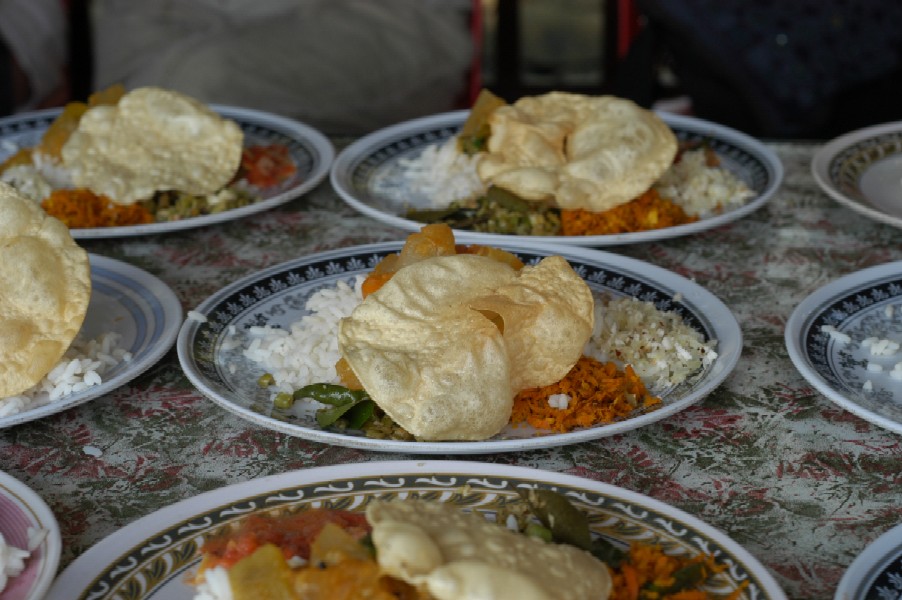 from the US who had been traveling for about six months. We chatted until they called us into the kitchen. We were joined by the mother and daughter from California that we had met on the backwater tour. We'd mentioned the class to them and they decided to come. There was also a young pair of Dutch travelers that joined us late. from the US who had been traveling for about six months. We chatted until they called us into the kitchen. We were joined by the mother and daughter from California that we had met on the backwater tour. We'd mentioned the class to them and they decided to come. There was also a young pair of Dutch travelers that joined us late.
The kitchen was narrow so we all squeezed in around the cook, the smiley woman of the house. She started with a Kerelan vegetable stew and moved so it to took all of our attention to follow along. It was hot and there wasn't even a little breeze through the kitchen. I could feel my forehead dripping with sweat. Rob videotaped while I wrote like mad and took photos. The recipe was fairly straightforward. She started by stewing all of the vegetables in coconut milk. Then she sizzled an assortment of dry aromatic spices in a small dab of oil. The aroma was wonderful - cloves, cinnamon stick, anis seeds, and cardamom pods. Next went in the fresh herbs - onions, chilies, ginger, curry leaf. Some tomatoes were added for a quick cook and then the spices mixture was   combined with the vegetable stew. Some coconut cream and fresh coriander finished the stew. combined with the vegetable stew. Some coconut cream and fresh coriander finished the stew.
The next dish was a cabbage thora, a kind of cabbage and shredded coconut stew that was served as a side dish. Shredded coconut was crushed together with green chilies, shallots, garlic, cumin seeds, turmeric, curry leaves and a bit of water. In some oil she sizzled some aromatic mustard seeds and then added the coconut mixture, then shredded cabbage and salt to taste. It cooked for ten minutes and was done. A wonderfully simple and tasty dish.
She moved on to a dhal (lentil) curry. The dhal had already been presoaked, substantially shortening the prep time on the dish. Again she started with the sizzling mustard seed then adding, in order, onions, ginger, garlic, chilies, and curry leaves. We started to see a trend in the spicy and savory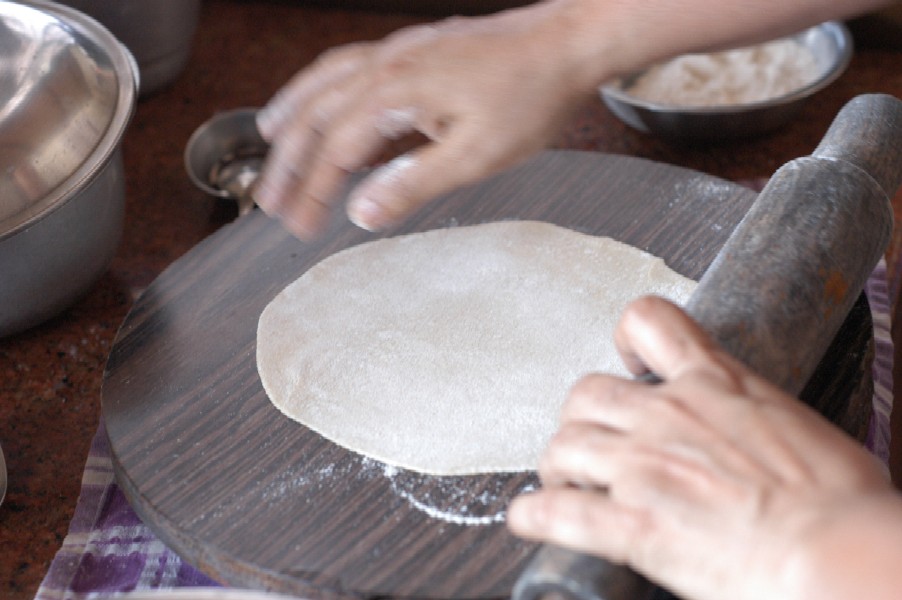 ingredients. She cooked everything until it was browned and then threw in a dash of chili powder. After a quick minute sauté she added some tomatoes until the mixture became pasty. Last came the dhal with the liquid they had been soaked in and it all cooked together another five minutes. A bit of fresh coriander topped off the curry. ingredients. She cooked everything until it was browned and then threw in a dash of chili powder. After a quick minute sauté she added some tomatoes until the mixture became pasty. Last came the dhal with the liquid they had been soaked in and it all cooked together another five minutes. A bit of fresh coriander topped off the curry.
The assortment of dishes were familiar and we realized it was almost an exact recreation of the dishes we eaten on our backwater tour. They were typically Kerelan dishes, very flavorful but lighter than northern Indian cooking and with more use of the readily available coconut. Our final task was to churn out some chapatis, like an Indian tortilla but thicker. The dough was easy, just one cup of wheat flour combined with a half cup of plain flour, some water and salt. She made ball with a pinch of dough and flattened it with a rolling pin. Somehow hers came out completely round. She kept flipping it and turning it to get just the right shape. She enlisted some volunteers from the group to give it a go but the results were more abstract. To cook the chapatis she used a non-stick pan and no oil, allowing one side to toast while she pressed the air-filled po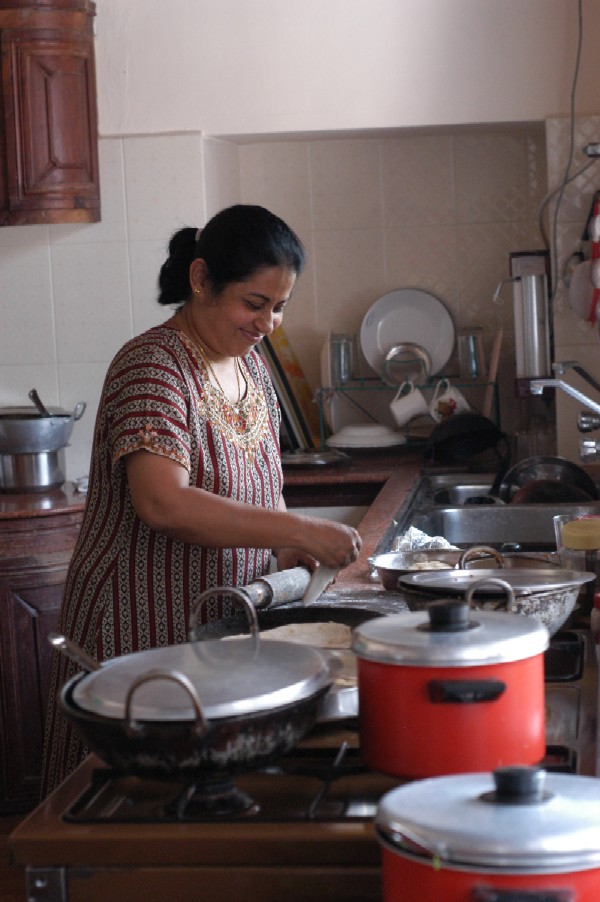 uches that rose down with a spatula. She flipped it and toasted the other side in the same way. At the very end she brushed one side with oil and then flipped the chapati a couple of times to coat it before removing it to a plate. uches that rose down with a spatula. She flipped it and toasted the other side in the same way. At the very end she brushed one side with oil and then flipped the chapati a couple of times to coat it before removing it to a plate.
We were directed to a long wooden dining table in the next room and they served up the dishes family style with a pot of rice. The whole class and meal only took about an hour and a half. They were all good and there was more than enough food for the group. With happy and full stomachs we enjoyed our last afternoon in Kochi. |

